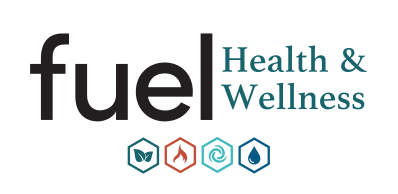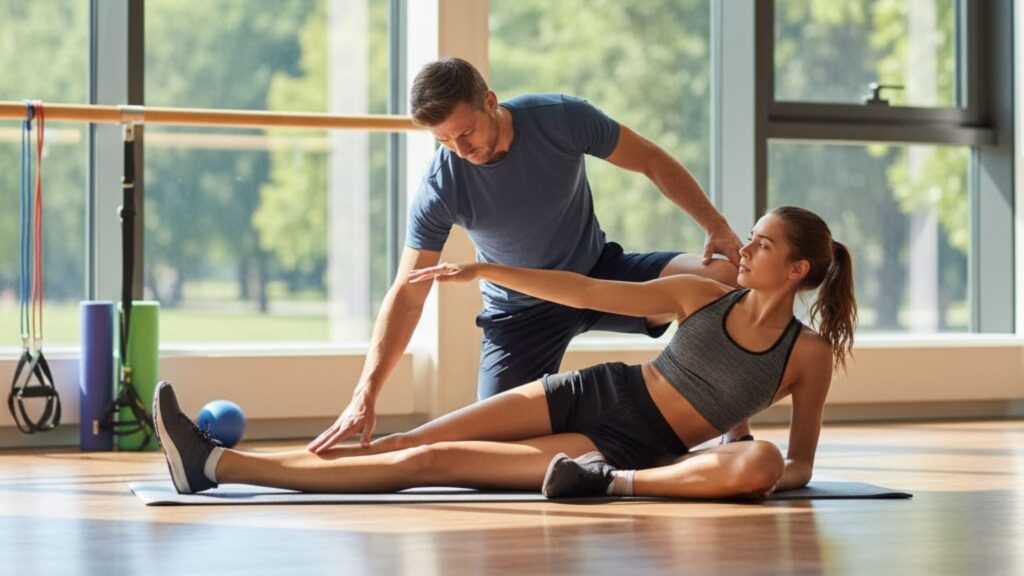If you’re an athlete, a dedicated weekend warrior, or someone who simply takes their physical well-being seriously, you know that performance is a constant, relentless pursuit. You track reps, measure speed, monitor nutrition, and perfect technique, yet one critical element often remains the final barrier to peak physical ability: flexibility and mobility. Many dedicated individuals hit a frustrating plateau, constrained not by a lack of effort, but by a subtle, creeping tightness in their muscles and connective tissues. This is where Assisted Stretch Therapy enters the picture, acting as the ultimate, targeted catalyst to break through these barriers, unlocking reserves of power, speed, and fluid movement you didn’t know you had. The difference between stretching alone and receiving professional assistance is the difference between simply maintaining and actively maximizing your body’s potential.
What are the primary mechanisms that make professional assisted stretch therapy more effective than self-stretching?
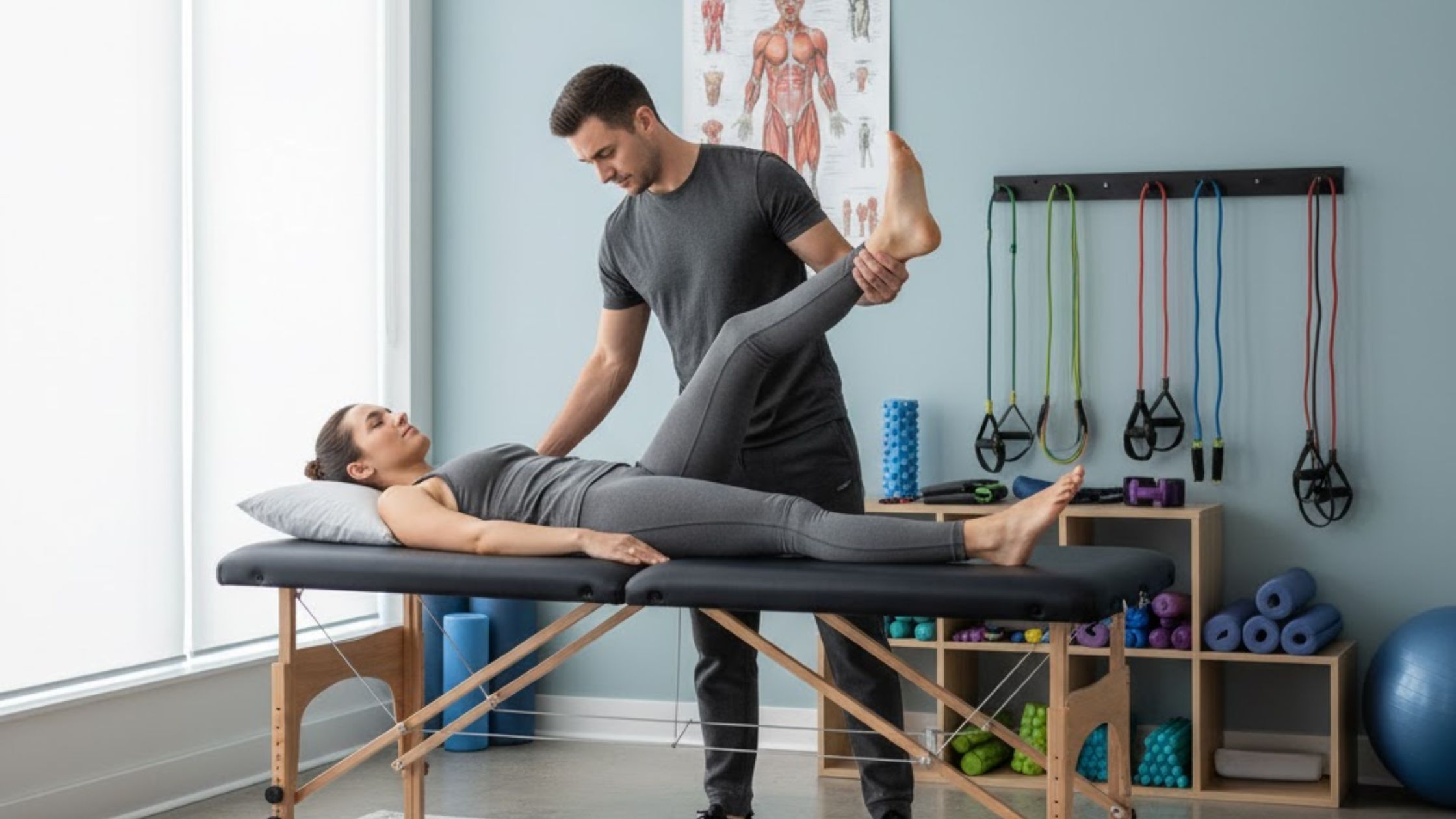
The core question for any serious athlete is simple: why pay for an expert to stretch you when you can do it yourself? The answer lies deep within the body’s neurological and biomechanical systems, which an experienced Stretch Therapist is trained to manipulate. Self-stretching, while valuable for daily maintenance, is fundamentally limited by the body’s natural protective response—the stretch reflex.
Understanding the Stretch Reflex and the Neuromuscular Advantage
The stretch reflex is a primitive survival mechanism designed to prevent your muscles from over-lengthening and tearing. When a muscle is stretched too far or too fast, sensory receptors called muscle spindles trigger an involuntary contraction, or “lockdown,” to shorten the muscle and protect the joint. This reflex is why you often feel resistance before you’ve reached your true end range of motion during solo stretching.
Professional assisted stretch therapy overcomes this protective barrier by utilizing advanced techniques that communicate with the nervous system. The therapist uses precise, controlled movements to gradually and gently move the muscle-tendon unit into a deeper stretch. By stabilizing the body and controlling the force, they bypass the trigger points for the reflexive contraction, allowing the muscle to achieve a greater degree of lengthening than is physically possible on your own. This controlled manipulation is the secret to rapid, measurable gains in range of motion (ROM).
The Power of Proprioceptive Neuromuscular Facilitation (PNF)
One of the most powerful techniques in the arsenal of a stretch specialist is Proprioceptive Neuromuscular Facilitation (PNF). PNF is not just passive stretching; it’s a dynamic, active process that leverages the body’s own physiological reflexes to achieve a profound, therapeutic release. The most common PNF method is the “Contract-Relax” cycle, a deliberate, three-step sequence.
In the PNF cycle, the therapist first moves the targeted muscle group—such as the hamstrings or hip flexors—to its point of resistance. Then, the client is asked to gently contract that same muscle against the therapist’s unmoving resistance for several seconds (the “Hold” or “Contract” phase). The theory is that this forceful contraction, through a process known as autogenic inhibition, momentarily fatigues the muscle and, crucially, relaxes the stretch reflex. Immediately following the contraction, the muscle is significantly more receptive to lengthening, allowing the therapist to safely and smoothly guide the client into a deeper, more therapeutic stretch. This results in superior and faster gains in athletic flexibility training compared to static stretching alone.
How does assisted stretch therapy specifically elevate an athlete’s range of motion and functional strength?
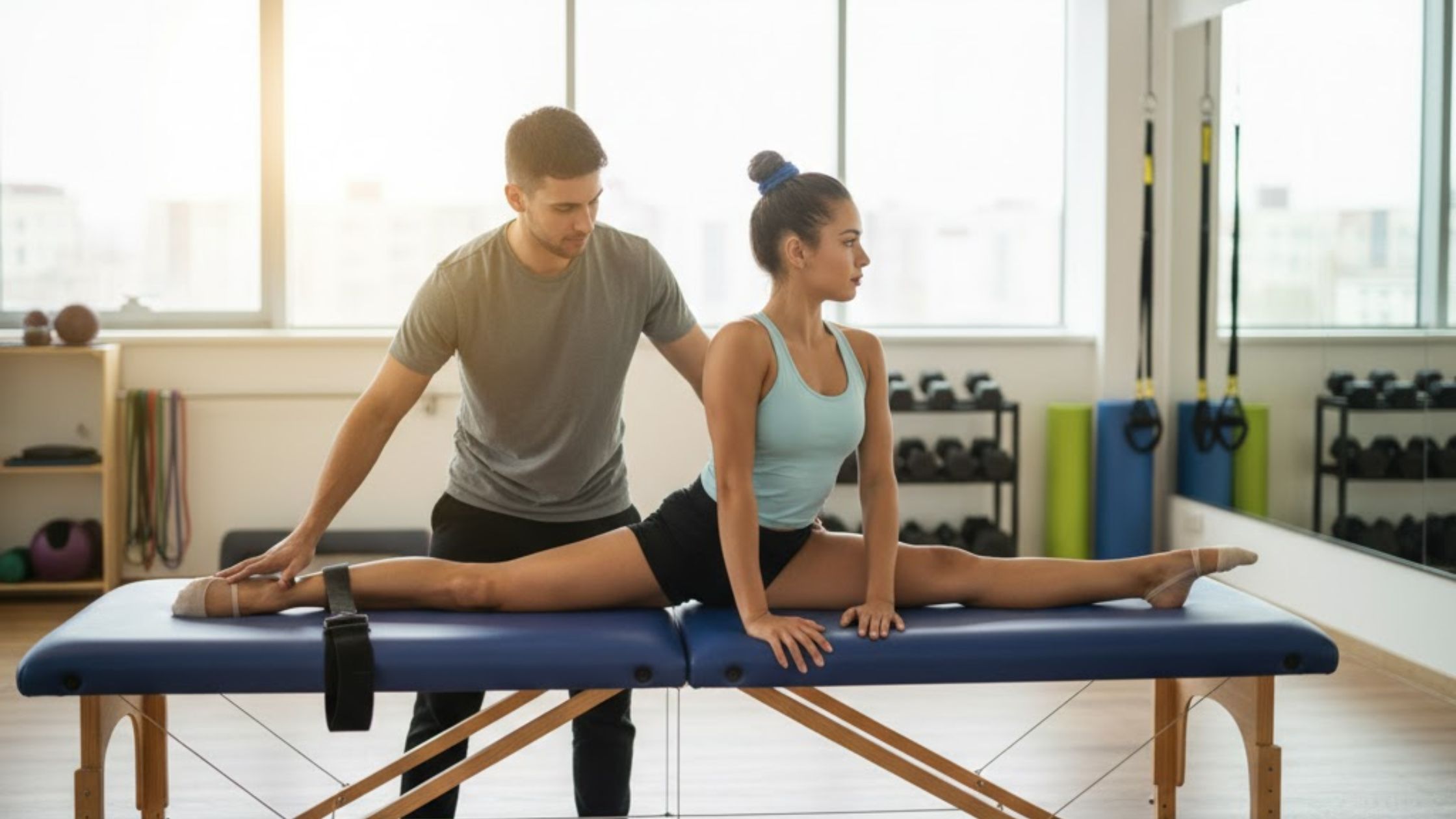
For an athlete, flexibility is not just about touching your toes; it’s about having a full, functional range of movement that translates into power and efficiency. Assisted Stretch Therapy directly addresses this by enhancing two critical components of athleticism: the length of the muscle-tendon unit and the health of the surrounding connective tissues.
Boosting Joint Range of Motion (ROM) for Explosive Power
A limited Range of Motion in a joint—the hip, shoulder, or ankle, for example—forces the body to compensate during high-demand movements. This inefficiency wastes energy and limits the potential for speed and power. Consider a sprinter with tight hip flexors and hamstrings. Their restricted ROM prevents their legs from achieving the full hip extension and knee drive necessary for a powerful, long stride.
By consistently and safely increasing the length of the muscle-tendon unit, assisted stretching effectively “resets” the joints to their optimal, uninhibited capacity. This allows for a greater arc of movement, meaning a runner can achieve a longer stride, a golfer can complete a fuller backswing, and a basketball player can jump higher. The enhanced ROM translates directly into functional strength because the muscle can now generate force over a greater distance, which is the definition of powerful, explosive movement.
The Critical Role of Fascial Health and Mobility
The concept of flexibility extends beyond the muscle fibers themselves to the surrounding fascia, the web-like connective tissue that encases muscles, groups of muscles, and organs throughout the body. When an athlete trains intensively, the fascia can become tight, sticky, and adhered, restricting the smooth gliding of muscle over muscle. This is a primary cause of chronic stiffness, discomfort, and restricted movement patterns.
Professional stretch therapists are trained in techniques, including targeted movements similar to myofascial release, to identify and gently manipulate these areas of fascial restriction. By applying precise tension and movement, the therapist helps to release these fascial adhesions, restoring the tissue’s natural elasticity and allowing muscles to move independently and efficiently. This improvement in fascial mobility is a profound game-changer for performance mobility therapy, as it allows for the fluid, coordinated movements essential in sports like gymnastics, martial arts, and complex ball sports. To get a closer look at the expertise we offer, please take a moment to meet the team of dedicated professionals at Fuel Health & Wellness.
How does regular assisted stretching accelerate recovery and minimize the risk of athletic injury?

The intensity of an athlete’s training regimen is directly proportional to their need for proactive recovery and injury mitigation. Without proper restoration, the cumulative micro-trauma from training leads to fatigue, muscle imbalance, and an increased susceptibility to severe injury. Assisted Stretch Therapy is an indispensable tool in this phase, addressing post-exercise soreness and structural vulnerabilities.
Rapid Reduction of Delayed Onset Muscle Soreness (DOMS)
Intense training causes microscopic tears in muscle fibers, a process necessary for muscle growth, but one that results in inflammation and metabolic waste accumulation. This leads to Delayed Onset Muscle Soreness (DOMS), which can sideline an athlete or significantly reduce the quality of subsequent training sessions.
Assisted stretching significantly enhances blood flow and circulation to the fatigued muscles. This improved vascular activity acts like a detoxification process, flushing out metabolic byproducts like lactic acid and delivering fresh, oxygenated blood and essential nutrients required for repair. The gentle lengthening also helps to realign the recovering muscle fibers, reducing the severity and duration of DOMS, meaning the athlete can return to peak form faster.
Correcting Muscle Imbalances and Proprioception
Over-training certain muscle groups while neglecting others is a common pitfall in high-volume sports, leading to muscle imbalances. For instance, a cyclist or runner often develops strong quadriceps and tight hip flexors, which can pull the pelvis out of alignment and contribute to lower back pain or knee issues. The expertise of a stretch therapist is crucial here, as they conduct a thorough assessment to identify these asymmetries.
Targeted, one-on-one stretches correct these imbalances by safely lengthening the chronically tight, dominant muscles. Furthermore, the assisted movement sharpens the body’s proprioception, or its spatial awareness and sense of joint position. A better sense of proprioception allows the athlete’s nervous system to coordinate muscle firing more precisely, which is vital for quick reaction times and complex athletic maneuvers, thereby serving as a direct mechanism for injury prevention. For a detailed overview of the benefits and to see if this service is right for you, check out our internal page on Assisted Stretch Therapy.
What is the difference between dynamic and static assisted stretching in an athletic context?
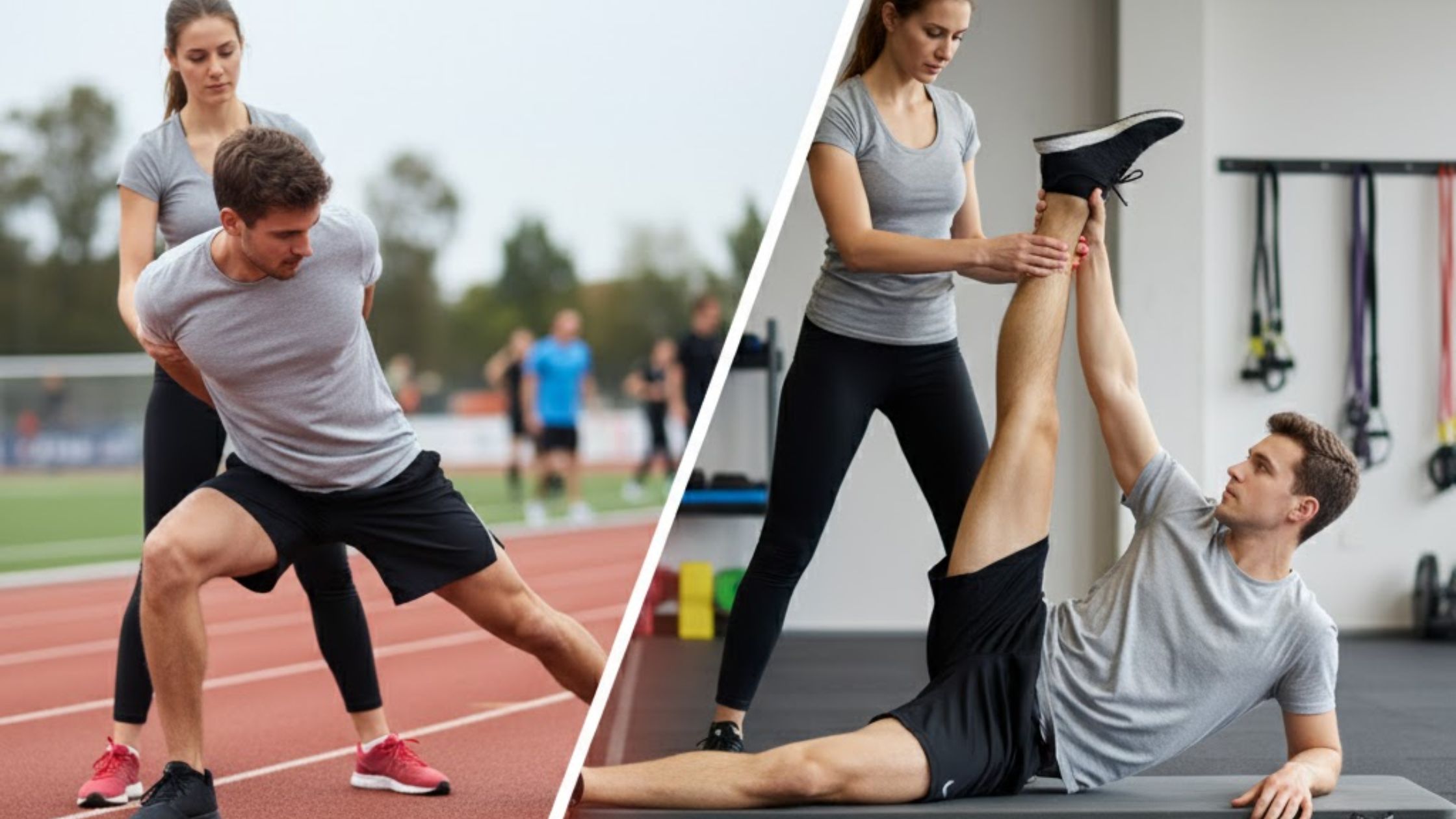
The terms ‘dynamic’ and ‘static’ refer to two distinct categories of stretching, each serving a specific, strategic purpose within an athlete’s preparation and recovery cycle. The proper application of each, often in an assisted capacity, is a hallmark of elite athletic programming.
Dynamic Assisted Stretching: The Pre-Workout Power Boost
Dynamic stretching involves movement through a range of motion, preparing the body for the intense activity ahead. When performed as Active Assisted Stretching, the therapist guides the limb through its maximal, yet comfortable, range. This is the ideal pre-workout activity because it:
- Elevates core body temperature without fatiguing the muscle.
- Improves neuromuscular control, enhancing the communication between the brain and the muscle.
- Restores physical functioning and flexibility for the specific movements required in the sport.
Unlike static stretching, which is generally discouraged immediately before an intense workout due to a temporary reduction in power output, dynamic assisted stretches prime the muscles and joints for explosive action.
Static Assisted Stretching: The Post-Workout Deep Release
Static stretching involves holding a stretch for an extended period—typically 30 seconds or more—with the goal of safely lengthening the muscle and surrounding connective tissues. In the assisted setting, this is performed passively, meaning the client is fully relaxed while the therapist applies the external force. This is optimally performed as a post-workout recovery tool because it:
- Facilitates deep muscle relaxation, supporting the activation of the parasympathetic nervous system for rest and repair.
- Focuses on lengthening the muscle-tendon unit for long-term flexibility gains.
- Reduces residual tension that accumulates from high-intensity training.
Combining these two approaches—dynamic before activity and static after—ensures that the athlete’s body is always optimally prepared and efficiently recovered. This holistic approach is foundational to the philosophy at Fuel Health & Wellness.
Frequently Asked Questions about Assisted Stretch Therapy
To provide the full authentic information our audience needs, here are five of the most common questions individuals ask about professional stretch sessions:
Is Assisted Stretching Considered a Medical Treatment?
While the benefits of assisted stretching—such as pain relief, injury rehabilitation support, and improved mobility—are therapeutic, it is generally not classified as a medical treatment in the same category as physical therapy or chiropractic care. It is best understood as a specialized, proactive form of performance mobility therapy and wellness, focusing on flexibility and ROM. It is a complementary service that should be integrated into a client’s overall fitness and wellness strategy, but it is not typically covered by standard medical insurance.
How Often Should I Perform Assisted Stretching to See Results?
Consistency is the most important factor. For individuals just starting out or looking for general maintenance, one session per week is a great starting point. Athletes, or those with significant mobility restrictions or chronic tightness, may benefit from two to three sessions per week to achieve rapid, measurable, and sustainable improvements in athletic flexibility training. Your stretch therapist at Fuel Health & Wellness will work with you to create a personalized schedule tailored to your sport, training volume, and recovery needs.
What Should I Wear to an Assisted Stretching Session?
The most important consideration is comfort and freedom of movement. You should wear loose-fitting or athletic clothing that is stretchy and unrestrictive, such as yoga pants, leggings, sweatpants, athletic shorts, and a comfortable top. Avoid clothing with heavy zippers, buttons, or rigid denim, as these can interfere with the therapist’s ability to position your limbs and could cause discomfort during deep stretches.
Can I Do Assisted Stretching Before or After a Workout?
Absolutely, and strategically timing your sessions can maximize your results. A pre-workout session should focus on dynamic, short-hold assisted stretches to warm up the muscles and prime the nervous system for activity. A post-workout session, which is often preferred for deeper lengthening and relaxation, should utilize static and PNF techniques to reduce soreness, accelerate recovery, and lock in the long-term gains in flexibility. The timing should align with your specific athletic goals.
Is Assisted Stretching Painful?
No, assisted stretching should never be painful. You will feel a strong, comfortable stretch—a sensation of the muscle lengthening and releasing tension—but it should not be sharp, shooting, or radiating pain. A skilled Stretch Therapist works within your body’s safe, tolerable limits, constantly communicating with you to monitor your feedback. The goal is a deep, therapeutic release, not an aggressive force that triggers the muscle’s self-protective mechanisms.
Integrating Assisted Stretch Therapy into Your Athletic Lifestyle
To achieve peak athletic performance and flexibility, a targeted, professional approach to mobility is non-negotiable. It is the key to minimizing the wear-and-tear of a demanding training regimen and unlocking the latent power stored within your body. The dedicated guidance of a Stretch Therapist provides access to deeper, more effective stretches using techniques like PNF that your body’s nervous system simply won’t allow you to achieve on your own.
This isn’t just about feeling less stiff; it’s about refining your movement mechanics, improving your coordination and proprioception, and giving your body the best possible chance to recover and adapt to training stress. By making Assisted Stretch Therapy a consistent and intentional part of your weekly routine, you are investing in your longevity, power, and ability to continually excel in your chosen sport.
| Athletic Focus Area | Benefit of Assisted Stretch Therapy | Key Mechanism |
| Performance | Increased Stride Length, Fuller Swing, Higher Jumps | Enhanced Range of Motion (ROM) & Functional Strength |
| Recovery | Faster Return to Training, Reduced Muscle Tenderness | Increased Blood Flow & Lactic Acid Flushing |
| Longevity | Reduced Strain on Joints & Connective Tissues | Correction of Muscle Imbalances & Fascial Release |
Final Words
For athletes in the US region who are ready to experience this transformative level of personalized care and elevate their capabilities, Fuel Health & Wellness offers bespoke assisted stretching programs. Our certified specialists are experts in translating mobility gains into tangible performance improvements. Whether your goal is to reduce chronic stiffness from a sedentary job, prepare for a major marathon, or simply gain the freedom of movement you deserve, we are here to guide you. If you have any further questions about how our specialized programs can fit into your life, we encourage you to contact us directly.
